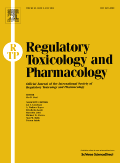
REGULATORY TOXICOLOGY AND PHARMACOLOGY
Scope & Guideline
Bridging Academic Excellence with Regulatory Insights
Introduction
Aims and Scopes
- Chemical Risk Assessment:
The journal prioritizes research on methodologies for evaluating the risks posed by chemical substances, including pharmaceuticals, agrochemicals, and industrial chemicals, ensuring that safety assessments are scientifically robust and regulatory compliant. - Innovative Methodologies:
A significant emphasis is placed on the development and validation of New Approach Methodologies (NAMs), which promote alternatives to traditional animal testing, such as in vitro assays, computational models, and other innovative techniques. - Pharmaceutical Safety Evaluations:
Research articles frequently focus on the safety assessment of drugs, including preclinical studies, toxicokinetics, and the implications of impurities, ensuring that pharmaceutical products meet stringent safety standards. - Environmental Toxicology:
The journal includes studies on the environmental impacts of chemicals, assessing exposure pathways, ecological risks, and the implications of human exposure to environmental toxicants. - Regulatory Frameworks and Policy Discussions:
Research often discusses regulatory frameworks, harmonization efforts, and policy implications related to toxicology and pharmacology, aiming to guide and inform regulatory practices globally. - Biomonitoring and Human Exposure Studies:
The journal features studies that assess human exposure to chemicals through biomonitoring techniques, aiming to evaluate health risks and inform public health policies.
Trending and Emerging
- Next Generation Risk Assessment (NGRA):
There is a growing trend towards integrating NGRA frameworks that utilize modern methodologies, including in silico predictions and machine learning models, to enhance the accuracy and efficiency of risk assessments. - Focus on Impurities and Contaminants:
Research increasingly addresses the risks associated with impurities and contaminants in pharmaceuticals and consumer products, with a particular emphasis on N-nitrosamines and other potentially harmful substances. - Ecotoxicology and Environmental Impact Assessments:
Recent publications reflect a heightened focus on the environmental impacts of chemicals, including studies on the ecotoxicity of substances and their effects on ecosystems, indicating an increased regulatory emphasis on environmental safety. - Biomonitoring and Human Health Studies:
The trend towards biomonitoring human exposure to chemicals is on the rise, with studies employing innovative techniques to assess exposure levels and their associated health risks, thereby informing public health policies. - Regulatory Harmonization Initiatives:
There is an increasing emphasis on regulatory harmonization efforts across jurisdictions, reflecting a global trend towards aligning safety assessment practices to facilitate international trade and public health protection.
Declining or Waning
- Traditional Animal Testing Methods:
There has been a noticeable decrease in the publication of studies reliant on traditional animal testing methods, as the field shifts towards NAMs and alternative testing strategies that emphasize reduction and refinement in animal use. - Historical Toxicological Data Analysis:
Research focusing solely on retrospective analyses of historical toxicological data has waned, possibly due to a growing preference for studies that integrate modern methodologies and real-time data analysis. - General Toxicological Profiles:
Submissions that provide broad or generic toxicological profiles without specific regulatory implications or innovative methodologies are less frequently seen, indicating a trend towards more focused and impactful research. - Single-Agent Toxicity Studies:
The emphasis on studies evaluating the toxicity of single agents in isolation is declining, as there is an increasing interest in understanding the effects of chemical mixtures and cumulative exposures. - Conventional Risk Assessment Models:
There is a reduction in the use of conventional risk assessment models that do not incorporate advanced statistical or computational techniques, reflecting a shift towards more sophisticated approaches in risk evaluation.
Similar Journals
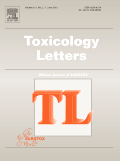
TOXICOLOGY LETTERS
Unveiling the impacts of substances on health and environment.TOXICOLOGY LETTERS is a prominent journal dedicated to advancing the field of toxicology, providing a platform for high-quality research and reviews that explore the effects of chemical substances on biological systems. Published by Elsevier Ireland Ltd, this peer-reviewed journal has established itself as a vital resource in toxicological research since its inception in 1977, with a convergence of studies extending to 2024. With an impressive Scopus ranking, positioned at #28 out of 133 in the Toxicology category, TOXICOLOGY LETTERS garners a respectable percentile of 79, highlighting its significance in the academic community. Although it is not an open-access journal, its research is accessible through institutional subscriptions, ensuring that critical insights into human health and environmental safety are disseminated effectively. Being categorized in the Q2 quartile in both Medicine (miscellaneous) and Toxicology for 2023 further emphasizes its relevance and impact in these fields. This journal aims to foster collaboration between researchers and professionals, encouraging the exploration of innovative solutions to chemical hazards and the promotion of safer practices in pharmacology and toxicology.
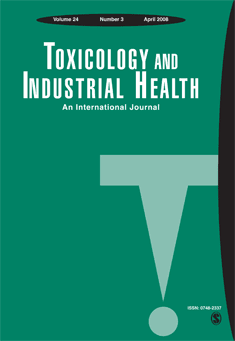
TOXICOLOGY AND INDUSTRIAL HEALTH
Transforming toxicology insights into real-world health solutions.TOXICOLOGY AND INDUSTRIAL HEALTH, published by SAGE PUBLICATIONS INC, is a premier journal in the field of toxicology, public health, and environmental health, with a significant history dating back to 1985. With its ISSN 0748-2337 and E-ISSN 1477-0393, the journal provides a platform for disseminating groundbreaking research and comprehensive reviews that address the complexities of toxic substances in industrial and occupational settings. Despite its Q3 ranking among peers in health, toxicology, and public health, this journal is becoming increasingly influential, reflected in its growing citation metrics. Researchers and professionals benefit from its commitment to fostering knowledge in both theoretical and practical contexts, making it an essential resource for those dedicated to advancing understanding in this vital field. The journal's main objectives include promoting research addressing the implications of toxicology on health and safety standards across industries, ensuring accessibility to current studies for a global audience. Overall, TOXICOLOGY AND INDUSTRIAL HEALTH plays a critical role in bridging the gap between research and real-world applications, proving invaluable to students, professionals, and researchers alike in their pursuit of enhancing public health and environmental safety.

Exposure and Health
Empowering researchers to tackle exposure assessment challenges.Exposure and Health is a pioneering journal published by Springer, specializing in the interdisciplinary fields of health, toxicology, and environmental sciences. With an ISSN of 2451-9766 and E-ISSN of 2451-9685, this open-access journal exemplifies a commitment to disseminating high-quality research that informs public health practices and policies globally. Situated in the Netherlands, it boasts an impressive impact factor and ranks in the top quartile (Q1) across multiple categories in the 2023 Scopus rankings, including Health, Toxicology and Mutagenesis, Pollution, and Water Science and Technology. The journal is dedicated to advancing knowledge on the interactions between environmental factors and health outcomes, making it a vital resource for researchers, professionals, and students in these critical fields. Exposure and Health actively encourages submissions that address the challenges of exposure assessment, risk management, and the promotion of sustainable public health initiatives.
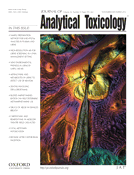
JOURNAL OF ANALYTICAL TOXICOLOGY
Advancing the Frontiers of Toxicological ResearchJOURNAL OF ANALYTICAL TOXICOLOGY, published by Oxford University Press Inc, stands as a leading platform in the field of analytical chemistry and toxicology, focusing on the rigorous exploration of methodologies and advancements in the detection of toxic substances. Since its inception in 1977, this journal has continually contributed to the scientific community, providing researchers and professionals with vital insights into chemical health, safety, and environmental implications. With an impressive Q1 ranking in both Analytical Chemistry and Chemical Health and Safety, along with reputable Q2 rankings in Environmental Chemistry and Toxicology, the journal maintains its critical standing in vibrant academic communities, ensuring the dissemination of high-quality research. Although it currently does not offer open access, articles are made available via institutional subscriptions, allowing widespread access to its valuable findings. Located in the United States, the journal contains a wealth of knowledge poised to benefit scientists and scholars engaged in toxicological research, emphasizing its importance in enhancing public health and safety.
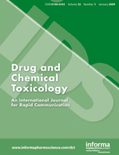
DRUG AND CHEMICAL TOXICOLOGY
Pioneering studies in drug and chemical safety.Drug and Chemical Toxicology is a well-respected journal in the fields of toxicology, pharmacology, and public health, published by Taylor & Francis Ltd. Since its inception in 1978, this journal has diligently explored the effects and mechanisms of chemical exposures on health and the environment, fulfilling a crucial role in advancing scientific understanding and safeguarding public health. The journal is indexed across prestigious databases and features an impressive array of articles categorized within the Q2 and Q3 quartiles across various categories in 2023, reflecting its significance in Chemical Health and Safety as well as Environmental and Occupational Health disciplines. With an extensive reach and a focus on interdisciplinary research, Drug and Chemical Toxicology offers a rich repository of original research, reviews, and methodological advancements, catering to a diverse audience of researchers, professionals, and students dedicated to the betterment of safety and health standards. Although not an open-access publication, its articles are widely accessible to the academic community, ensuring that critical innovations and insights are shared for the greater good.
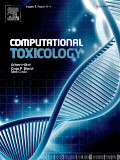
Computational Toxicology
Elevating toxicology with rigorous computational frameworks.Computational Toxicology is a premier journal published by Elsevier, dedicated to advancing the field of computational approaches in toxicological research. With an ISSN of 2468-1113, this journal provides a platform for researchers and professionals to share their innovative studies and methodologies from 2017 through 2024, promoting insightful discourse in essential areas such as computer science applications and toxicology. Recognized for its rigor and impact, it currently holds a Q2 ranking across various categories, including Computer Science Applications, Health, Toxicology and Mutagenesis, and Toxicology, highlighting its significance in the academic community. The journal is indexed in Scopus, boasting notable ranks including #284/817 in Computer Science Applications and #58/148 in Health, Toxicology and Mutagenesis, demonstrating its vital contribution to addressing contemporary challenges in environmental health and pharmacology. While it is not an open access journal, Computational Toxicology offers valuable insights for students, researchers, and practitioners striving to leverage computational frameworks to enhance the safety and efficacy of substances in human health and the environment.
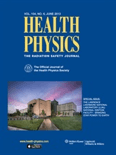
HEALTH PHYSICS
Exploring the Intersection of Health and PhysicsHEALTH PHYSICS is a leading academic journal dedicated to the study and dissemination of knowledge in the fields of radiology, epidemiology, and health toxicology. Published by Lippincott Williams & Wilkins, this esteemed journal has been a cornerstone of research since its inception in 1958, and it continues to foster important discussions and advancements in the discipline. With a notable impact factor and consistently ranking in the Q2 and Q3 quartiles across various categories in 2023, HEALTH PHYSICS serves as a vital resource for scholars, practitioners, and students seeking the latest insights and methodologies in the management of radiation exposure and its health implications. While the journal does not offer open access, it remains a critical platform for peer-reviewed articles that contribute to public health and environmental safety. The journal's comprehensive scope and historical significance underscore its importance in advancing knowledge and practices within its field, making it an essential read for anyone engaged in the multidisciplinary realms of health physics.
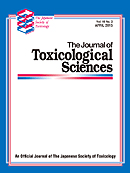
JOURNAL OF TOXICOLOGICAL SCIENCES
Enhancing Knowledge in Toxicology and BeyondThe Journal of Toxicological Sciences, published by the Japanese Society of Toxicological Sciences, is a prominent academic journal dedicated to the comprehensive study of toxicology and its related fields. Since its inception in 1976, the journal has provided a vital platform for researchers and professionals to disseminate innovative findings and insights in toxicology, with a focus on both experimental and clinical studies. Positioned in the Q3 quartile across various relevant categories, including Medicine (miscellaneous) and Toxicology as of 2023, the journal plays an essential role in advancing our understanding of toxic substances and their effects on biological systems. Although currently not open access, the journal maintains high academic standards and is indexed in Scopus, ranking #96 in Toxicology. Offering unique perspectives from Japan, it encourages global collaboration and discourse among toxicologists, making it an invaluable resource for students, researchers, and industry professionals alike.
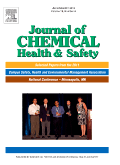
ACS Chemical Health & Safety
Fostering a culture of safety in chemical sciences.ACS Chemical Health & Safety, published by the American Chemical Society, serves as a vital resource in the field of chemical health and safety. With the ISSN 1871-5532 and E-ISSN 1878-0504, this journal focuses on advancing knowledge regarding safety practices in chemical research and industry, promoting the development of safer practices and technologies. It holds a respectable position with a 2023 categorization of Q3 in Chemical Health and Safety, Q2 in miscellaneous Chemistry, and Q3 in Public Health, Environmental and Occupational Health. Positioned in the United States, ACS Chemical Health & Safety is accessible through various platforms, ensuring that the latest research reaches a wide audience. As the journal converges years from 2006 to 2024, it continuously aims to disseminate high-quality research articles that enhance the understanding of hazards and risk mitigation strategies. By providing critical insights and fostering a culture of safety, this journal plays a crucial role in the ongoing discourse among researchers, professionals, and students in the domain of chemical sciences.
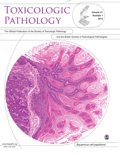
TOXICOLOGIC PATHOLOGY
Pioneering Research for a Safer, Healthier FutureTOXICOLOGIC PATHOLOGY, published by SAGE Publications Inc., is a dedicated journal that serves as a pivotal platform for researchers and professionals in the fields of toxicology and pathology. With an ISSN of 0192-6233 and E-ISSN of 1533-1601, the journal has been committed to advancing knowledge since its inception in 1972. It boasts impressive rankings in the recent 2023 category quartiles, achieving Q2 in Pathology and Forensic Medicine, and Q3 in Cell Biology, Molecular Biology, and Toxicology, marking it as a significant contributor to these vital disciplines. Despite its non-open access status, the journal ensures accessibility through various premium library subscriptions, providing readers with essential insights on toxicologic and pathologic research, advancing both academic inquiry and practical applications. Researchers, students, and industry professionals alike will find TOXICOLOGIC PATHOLOGY an indispensable resource, offering high-quality peer-reviewed articles that explore the complex interactions between substances and biological systems, with the aim of improving public health and safety.